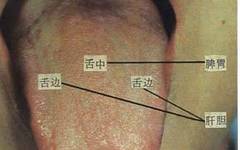Here are commonly seen clinical tongue diagnosis charts. For those who love Traditional Chinese Medicine (TCM), do not forget to collect them. Feel free to share with your friends so that more people can benefit.

Tongue Diagnosis Organs Mapping

According to the “Neijing” (Inner Canon), different parts of the tongue can reflect pathological changes in various organs, which has certain clinical reference significance. The tip of the tongue corresponds to the upper jiao (heart and lungs); the middle part corresponds to the middle jiao (spleen and stomach); the root corresponds to the lower jiao (kidneys); the sides correspond to the liver and gallbladder.
“Shanghan Zhi Zhang · Cha She Bian Zheng Fa” also states that “the tip of the tongue belongs to the upper jiao, the middle of the tongue belongs to the middle jiao, and the root of the tongue belongs to the lower jiao”.
Tongue Color Section
1. Normal Tongue

The characteristics of a normal tongue are: a light red color, moist texture, moderate size, and flexibility; the tongue coating is even, thin, white, and moist, referred to as “light red tongue, thin white coating“.
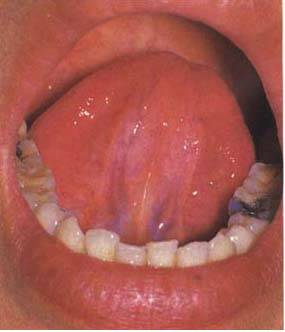
The normal sublingual veins are only faintly visible, appearing as purple-red lines, and should not be swollen. Most are single branches, with the largest diameter not exceeding 2.7mm, and the length generally does not exceed 3/5 of the line connecting the tip of the tongue and the sublingual meat mound.
2. Pale White Tongue
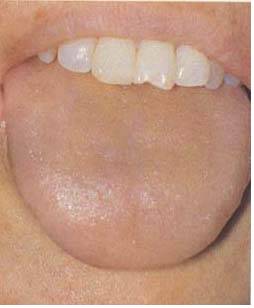
A pale white tongue is often seen in cases of yang deficiency with excessive cold, and qi deficiency with insufficient blood. This tongue is pale white, with a thin white and moist coating, indicating deficiency of both qi and blood.
3. Withered White Tongue
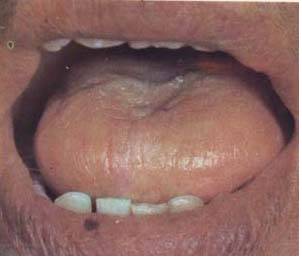
The tongue color and the gums and lips show no blood color, referred to as “withered white”. This tongue appears withered and dry, unable to extend, indicating decline of vital essence, critical condition.
4. Red Tongue
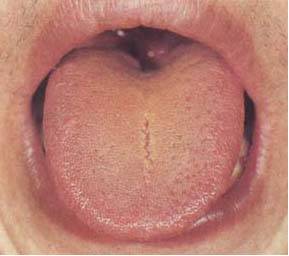
A red tongue is seen in cases of external heat or yin deficiency with excessive fire. This tongue is red, with a thin yellow coating, and the tongue texture is rough, indicating excessive heat in the qi level.
5. Red Tip of the Tongue

A red tip of the tongue is often seen in cases of heart fire rising, indicating heat in the upper jiao. This tongue has a red tip with prickles, while the rest is light red and moist, indicating excessive heat in the upper jiao.
6. Deep Red Tongue (1)
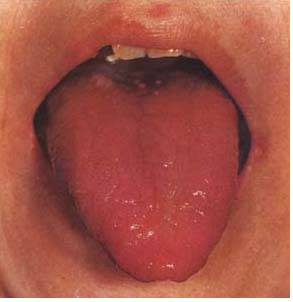
A deep red tongue, referred to as “deep red tongue”, indicates excessive heat. In cases of external diseases, it is a sign of pathogenic heat entering the nutrient level; in internal injuries with yin deficiency and severe fire, it is also commonly seen. This tongue is deep red and dark, with leaf-like shallow cracks on the surface and little coating, indicating excessive heat, stagnation of qi and blood, and damage to the righteous qi.
7. Deep Red Tongue (2)
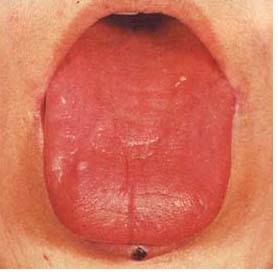
This image is from a patient with chronic gastric fire, showing a deep red tongue, dry with no coating, and shallow cracks on the surface, indicating internal heat blazing, gastric yin depleted, and significant damage to gastric qi.
8. Deep Red Tongue (3)
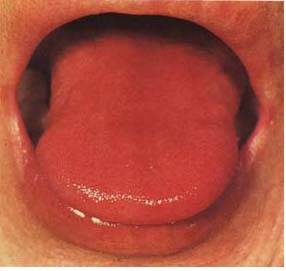
A deep red tongue with little coating and many red spots (i.e., fungal-like congestion) on the front indicates excessive pathogenic heat, injury to both qi and yin.
9. Cyanotic Purple Tongue

A cyanotic purple tongue is caused by poor circulation of qi and blood. This image shows a patient with chronic bronchitis and secondary infection, pulmonary emphysema, and heart failure, with a dark purple tongue and white greasy coating, indicating phlegm and fluid retention, lung and kidney qi deficiency, and blood stasis.
10. Pale Purple Tongue

A pale purple tongue is often seen in cases of yang deficiency with excessive yin. This image shows a patient with pulmonary heart disease, with a pale purple tongue and thin white moist coating, indicating insufficient yang qi and poor blood circulation.
11. Pale Purple Stagnation Tongue

This image shows a patient with menstrual irregularities (dysmenorrhea), with a pale purple tongue and many purple spots, and a thin white moist coating, indicating insufficient yang qi and cold stagnation with blood stasis.
12. Purple Red Tongue

This image shows a patient with a constitution of yin deficiency, with a red tongue and little coating, due to lung infection and heart failure, with a purple-red tongue, accompanied by fever and cough, indicating internal heat and stagnation of qi and blood.
13. Purple Red Tongue

A purple-red tongue with prickles indicates phlegm heat stagnation.
14. Stasis Spot Tongue

The presence of stasis spots or stasis points on the tongue indicates blood stasis. This image shows irregularly shaped stasis spots on the sides and edges of the tongue, indicating blood stasis in the liver channel.
Tongue Coating Section
The normal tongue coating is generated by the stomach qi and stomach yin rising to the tongue surface, while pathological tongue coating is formed when the stomach qi carries pathogenic qi upward. This atlas introduces various common tongue coating changes based on coating color and texture changes.
1. Thin White Moist Coating

This image shows a normal tongue coating. The coating is moist, and through the coating, a light red tongue texture can be seen, referred to as “thin white moist coating”. It indicates strong stomach qi and abundant fluids.
2. Thin White Slippery Coating

The tongue coating is excessively moist, feeling slippery and smooth to the touch, and may even drip saliva when the tongue is extended, referred to as “slippery coating”, often due to water dampness or phlegm retention. This image shows an overly moist tongue surface, with a thin white coating, slightly thicker at the root, and a plump tongue body with tooth marks on the edges, indicating yang deficiency with stagnant water dampness.
3. White Greasy Coating

The characteristics of greasy coating are: the coating is fine and dense, tightly adhering to the tongue surface, and does not come off when scraped, often caused by damp turbidity, phlegm retention, or food stagnation.
4. White Slippery Greasy Coating

This image shows a patient with chronic bronchitis, with a white greasy coating, excessive moisture on the tongue, a pale purple tongue, and stasis points on the tip. It indicates insufficient yang qi and phlegm retention.
5. White Thick Greasy Coating

The greasy coating is covered with a layer of dirty, slippery mucus, referred to as “sticky greasy coating”. It indicates excessive damp turbidity, obstructing the spleen and stomach yang qi.
6. White Thick Greasy Coating

This image shows a patient with liver cirrhosis and ascites, with a pale purple tongue and a white greasy coating that is thicker in the middle, indicating internal yang deficiency with excessive yin, water dampness accumulation, and poor blood circulation.
7. White Thick Loose Coating

The tongue coating gradually changes from greasy to loose, with coarser granules, floating on the tongue surface, and can be scraped off, indicating recovery of yang qi, gradually transforming cold dampness and yin pathogens.
8. White Greasy Coating Transforming to Dry

This image shows a patient with chronic bronchitis, originally with a white thick greasy coating, now most of the coating has transformed to dry, with cracks in the coating, and a patch of coating has fallen off, while the edges still have white coating that has not yet dried. It indicates phlegm and fluid stagnation transforming into heat, gradually damaging stomach qi and fluids.
9. Yellow Greasy Coating Transforming to Dry

This image shows a tongue with yellow greasy coating covering the surface, with the middle and front parts of the coating gradually transforming to dry, indicating internal heat blazing, dampness transforming to dryness.
10. Thin Yellow Coating

This image shows a patient with respiratory tract infection and fever. The tongue texture is slightly red, with a thin yellow coating, indicating exterior pathogens entering the interior, excessive heat in the qi level.
11. Yellow Greasy Coating (1)

Yellow greasy coating is often seen in cases of damp heat, phlegm heat, food stagnation transforming into heat, summer heat, damp heat, and unbeneficial qi. This image shows a patient after influenza, with a light yellow thick greasy coating, chest tightness, and poor appetite, indicating damp heat obstructing the middle, spleen losing its healthy function.
12. Yellow Greasy Coating (2)

This image shows a patient with biliary tract infection, with yellow greasy coating, indicating damp heat accumulation in the liver and gallbladder.
13. Yellow Greasy Coating (3)

This image shows a patient with liver cancer, with a red tongue and yellow thick greasy coating, with red spots on the tip, indicating interference of dampness and stagnant heat.
14. Yellow Sticky Greasy Coating

This image shows a patient with intestinal obstruction, with yellow greasy coating, and a layer of yellow sticky mucus covering the tongue surface, caused by obstruction of the bowel qi, with damp turbidity rising to the tongue.
15. Yellow Slippery Coating

Yellow coating can also be seen in cold damp conditions, characterized by yellow and moist coating with abundant fluids, a plump tongue, and often pale white color, or with tooth marks on the edges. It indicates yang deficiency, phlegm retention, or cold dampness accumulation.
16. Yellow Dry Coating (1)

This image shows a patient with lung infection, with the tongue coating changing from white to yellow (with some white greasy coating remaining), indicating disease transforming from cold dampness to heat, with fluids already damaged.
17. Yellow Dry Coating (2)

The tongue surface is very dry, with yellow thick dry coating, rough granules, and cracks on the front part of the tongue, indicating excessive heat and severe damage to fluids.
18. Yellow Petal Coating

The tongue coating is cracked into petals, yellow and dry, with a red tongue and shallow cracks, indicating a sign of excessive heat damaging fluids. This image still shows some white greasy coating, indicating that the original pathogenic factors were phlegm, dampness, and other yin pathogens.
19. Grayish White Greasy Coating

The tongue coating changes from white greasy to gray, often seen in yang deficiency with cold dampness, phlegm retention, and other yin pathogens accumulating in the middle jiao, not resolving over time.
20. Grayish Yellow Greasy Coating

This image shows a patient with pulmonary heart disease, with grayish yellow greasy coating and a dark purple tongue, indicating damp turbidity and phlegm heat transforming, with poor circulation of qi and blood.
21. Dirty Greasy Gray Coating

The tongue coating is greasy and sticky, grayish yellow, with a layer of dirty substance on the tongue surface, referred to as “dirty greasy coating”. It indicates excessive damp turbidity.
22. Black Greasy Coating

This image shows a patient with lobar pneumonia, with the tongue coating changing from white greasy to black greasy, with a red tongue and prickles on the tip, indicating internal heat blazing, with damp turbidity transforming into fire.
23. Charred Black Coating

This image shows a patient with biliary tract infection, with a red and dry tongue, with black dry coating at the root, and a little white greasy coating on the sides, indicating excessive heat and dampness transforming into dryness, damaging fluids.
24. Black Dry Coating

This image was taken two days before the death of a patient with gastric cancer, showing a black dry coating, with the root covered in black coating resembling black hair, and a shriveled tongue with no luster, indicating depletion of yin fluids and extreme internal heat.
25. Coating Loss

Where the coating has fallen off, the tongue surface is smooth and without coating, referred to as “coating loss”. It indicates deficiency of stomach yin and stomach qi, or insufficient qi and blood, unable to nourish and regenerate new coating.
26. Greasy Coating with Partial Loss (1)

This image shows a patient with pulmonary heart disease and heart failure, originally with a white greasy coating, now with partial loss in the middle and front of the tongue, while the sides still have yellow and white greasy coating, with a cyanotic purple tongue, indicating phlegm heat obstructing, poor circulation of qi and blood, and deficiency of stomach qi.
27. Greasy Coating with Partial Loss (2)

The tongue coating is thick and greasy, with areas of coating loss, indicating phlegm and dampness not transforming, stomach qi has been damaged, and the condition is mixed with deficiency and excess.
28. Similar Coating Loss

This image shows a patient with a gastric ulcer, with multiple areas of coating loss, where the lost areas still have new papillae, referred to as “similar coating loss”. It indicates insufficient qi and yin, with slow regeneration of tongue coating.
29. Geographic Tongue

Geographic tongue is a type of coating loss, characterized by irregular patterns resembling a map, with slightly raised edges, and the location changes over time, also caused by insufficient stomach qi and stomach yin. It is often seen in individuals with allergic constitutions. This image shows the tongue after treatment, with new coating growing in the areas of loss.
30. Mirror Tongue

The tongue has atrophied papillae, with all coating completely gone, and the tongue surface is smooth like a mirror, referred to as “mirror tongue”, indicating depletion of stomach qi and stomach yin. It is often seen in late stages of heat diseases damaging yin, internal yin deficiency, and deficiency of both qi and blood. This is a red mirror tongue caused by excessive heat and depletion of yin fluids.
31. Rootless Coating (1)

The tongue coating floats on the surface, easily scraped off, and cannot regenerate new coating underneath, caused by severe damage to stomach qi and stomach yin, leading to loss of nourishment for the tongue coating. This image shows a patient with late-stage liver cancer, with a red tongue, prickles on the tongue surface, and yellow turbid coating that falls off without scraping, indicating internal heat blazing, severe damage to stomach yin.
32. Rootless Coating (2)

This image shows the tongue after scraping. Most of the granular yellow coating has been scraped off, with no new coating regenerating on the tongue surface, indicating damage to stomach qi and stomach yin, with a more severe condition.
33. Thin White Coating and Yellow Thick Greasy Coating

(Thin White Coating)

(Yellow Thick Greasy Coating)
The dynamic changes of tongue appearance are significant for assessing the progression and outcome of diseases. These two images show the same patient at different times. At the onset of the disease, the tongue coating is thin white, and after a few days, as the pathogenic factors enter the interior and transform into heat, the tongue coating changes to yellow thick greasy.
34. Yellow Thick Greasy Coating and

(Yellow Thick Greasy Coating)

(Thin White Coating)
Yellow thick greasy coating indicates drug allergy, initially presenting as yellow thick greasy coating, which has mostly retreated after treatment for dampness, indicating that damp turbidity has transformed.

